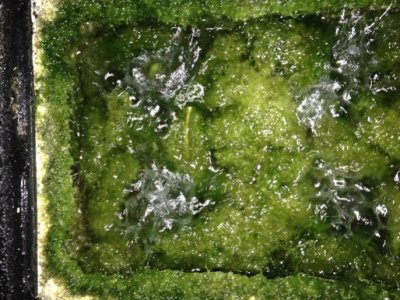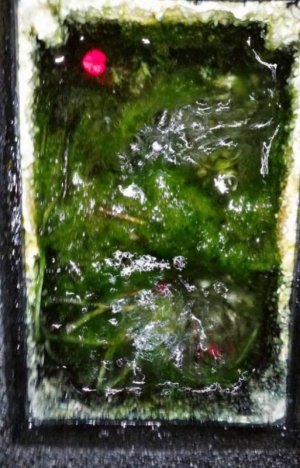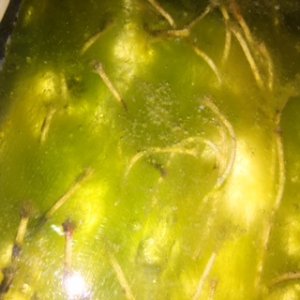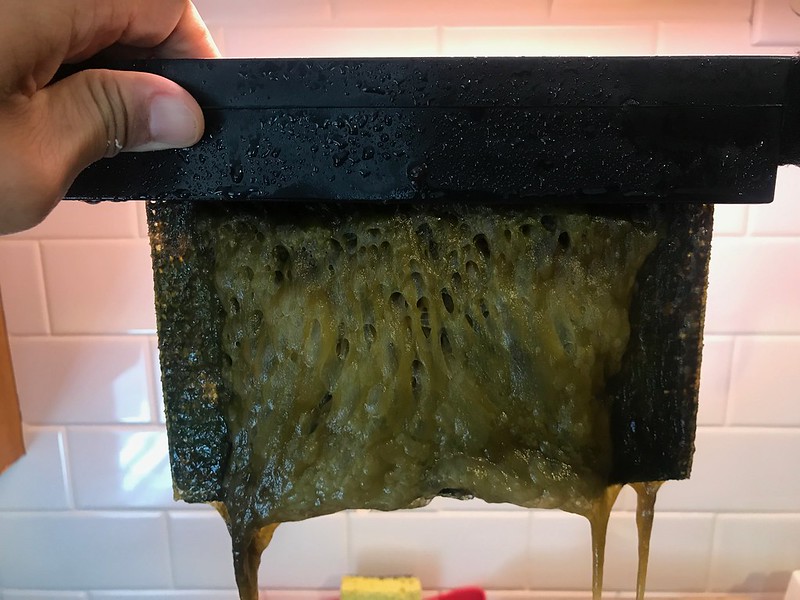Floyd R Turbo
Either busy or sleeping
It's really the other way around - you should size the screen according to your bioload, which is primarily related to how much you feed.
It appears that you might have used the previous guideline, which was based on tank volume? But I think you are running one-sided, so that's a factor.
8.5x11, less the 1.5", 7x11 = 77 sq in, at 12 sq in/cube/day that's over 6 cubes/day capacity, then cut that in half (or more) for single sided, you're at 3 cubes/day. So maybe not that far off, but the point being that if you feed 2-3 cubes/day, you could have built a screen with an active growth area of 36 sq in and light it on both sides - would take up less room and you wouldn't need as much flow (smaller pump, less heat, less power, etc)
I'm in agreement that the light is maybe a bit much, at least initially. You may get bald spots in front of the LEDs, or if they are overall just too intense, the entire center of the screen will be bare and it will get growth around the edges - but should eventually fill in (might take a while).
As for flow, your max flow should be 35 GPH/in of screen width. You can start out with a lot less, as the initial break-in period doesn't really require a ton of flow. You could drop it down to 25 GPH/in or maybe less - the thing to do is just adjust the flow so that you get coverage on most of the screen without arcing (too much) or leaving the far end dry (too little).
Back to the light - intensity is good, if you have the nutrients to support it and the algae growth is mature. Initially, high intensity is growth-prohibitive. In order to knock down the intensity, you first have to consider the fixture and what it prevents you from doing.
In this case, I'm willing to bet that the front panel of the fixture is glass, and it gets hot after it's been running for a few hours. So I would not use any type of cloth that gets into direct contact with the fixture, and I would not attach anything to the front of the fixture or the glass. No tape, no diffuser, etc.
What I would instead do is one of the following:
1) get a piece of diffuser from Home Depot/Lowes/etc and cut it to match the footprint of the light, then attach that to the clear scrubber panel. This stuff is like what is in a 2'x4' recessed ceiling grid light fixture. It is smooth on one side, and bumpy on the other. Cut carefully as it shatters, it's best to use a razor knife and make multiple passes before snapping it (and wear eye protection, and use gloves...trust me on this!)
2) if you use a cloth, attach to the scrubber clear acrylic.
3) add pieces of blue painters tape on the scrubber clear acrylic, lined up with the LED centers. These only need to be 1cm square, that will block the bulk of the intensity.
4) combine 1 & 3, attaching the tape to the diffuser. This might be preferred as you can more easily remove the tape a few at a time to increase intensity, and the tape won't leave goo behind on the scrubber (since it is on the diffuser)
Keep in mind, a lot of factors that affect how a scrubber works are dependent on your tank. For this reason, I try to stay away from some "hard line" do's and don'ts - what works for some may not work for you.
HTH
Bud
It appears that you might have used the previous guideline, which was based on tank volume? But I think you are running one-sided, so that's a factor.
8.5x11, less the 1.5", 7x11 = 77 sq in, at 12 sq in/cube/day that's over 6 cubes/day capacity, then cut that in half (or more) for single sided, you're at 3 cubes/day. So maybe not that far off, but the point being that if you feed 2-3 cubes/day, you could have built a screen with an active growth area of 36 sq in and light it on both sides - would take up less room and you wouldn't need as much flow (smaller pump, less heat, less power, etc)
I'm in agreement that the light is maybe a bit much, at least initially. You may get bald spots in front of the LEDs, or if they are overall just too intense, the entire center of the screen will be bare and it will get growth around the edges - but should eventually fill in (might take a while).
As for flow, your max flow should be 35 GPH/in of screen width. You can start out with a lot less, as the initial break-in period doesn't really require a ton of flow. You could drop it down to 25 GPH/in or maybe less - the thing to do is just adjust the flow so that you get coverage on most of the screen without arcing (too much) or leaving the far end dry (too little).
Back to the light - intensity is good, if you have the nutrients to support it and the algae growth is mature. Initially, high intensity is growth-prohibitive. In order to knock down the intensity, you first have to consider the fixture and what it prevents you from doing.
In this case, I'm willing to bet that the front panel of the fixture is glass, and it gets hot after it's been running for a few hours. So I would not use any type of cloth that gets into direct contact with the fixture, and I would not attach anything to the front of the fixture or the glass. No tape, no diffuser, etc.
What I would instead do is one of the following:
1) get a piece of diffuser from Home Depot/Lowes/etc and cut it to match the footprint of the light, then attach that to the clear scrubber panel. This stuff is like what is in a 2'x4' recessed ceiling grid light fixture. It is smooth on one side, and bumpy on the other. Cut carefully as it shatters, it's best to use a razor knife and make multiple passes before snapping it (and wear eye protection, and use gloves...trust me on this!)
2) if you use a cloth, attach to the scrubber clear acrylic.
3) add pieces of blue painters tape on the scrubber clear acrylic, lined up with the LED centers. These only need to be 1cm square, that will block the bulk of the intensity.
4) combine 1 & 3, attaching the tape to the diffuser. This might be preferred as you can more easily remove the tape a few at a time to increase intensity, and the tape won't leave goo behind on the scrubber (since it is on the diffuser)
Keep in mind, a lot of factors that affect how a scrubber works are dependent on your tank. For this reason, I try to stay away from some "hard line" do's and don'ts - what works for some may not work for you.
HTH
Bud




